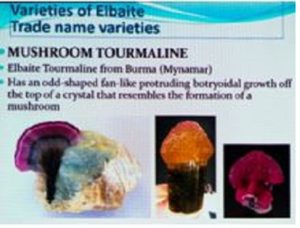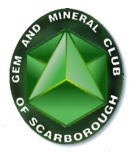September Meeting 2018: Tourmaline
Tatliana Ivaniouchina gave attendees a fabulous presentation about the mineral tourmaline. She had various mineral samples from her collecting trip to Pala California. She even let us take a sample home.
Pala California is famous for its pink tourmaline. Tourmaline comes in all colours but purple. This is why

it is frequently confused with other minerals like sapphires and rubies. Tourmaline crystals are usually elongated prismatic columns with striations along its length. It can have 3, 6 or 9 sides. The faces of the triangular prism are often convex giving them a rounded triangular cross section. Because of the striations you frequently get a cat’s-eye effect when tourmaline is made into cabochons. Tourmaline is a cyclo-silicate mineral where the silicate chains link together to form rings. Tourmaline is formed when watery magma cools down.
Green tourmaline has been confused with emeralds but in the 1800’s it was recognized as its own mineral. Red tourmalines have appeared in crown jewels because they were originally thought to be rubies. Tourmaline cannot be synthesized in pieces larger than a few microns so tourmaline is imitated by glass and other minerals.
In the 1850’s ex gold rush miners were looking for their fortune along the San Luis Rey River near Oceanside

**California. They found pink and green crystals and followed them like a trial of bread crumbs up to Pala and then into Majestic Queen Mountain. Here they found pegmatite spewing brightly coloured gems into Salmon Creek by erosion. This pegmatite later became the Stewart Lithia Mine. It quickly became the largest lithium mine in the US. It has huge reserves of Lepidotite ore and the source of the most vivid pink tourmaline ever found.
The tourmaline group of minerals consists of many members. The most well-known are Elbaite, Schorl and Dravite. Lesser known members are Uvite, Liddicoatite and Buergerite. Tourmaline has piezoelectric and pyroelectric properties. Piezoelectri properties: when the crystal is compressed, rubbed or vibrated different electrical charges will collect at opposite ends of the crystal. Conversely when an electric charge is applied the crystal will vibrate. Pyroelectirc means the when the crystal is heated different charges will collect at different ends of the crystal. Dust hair and fluff are attracted to tourmaline crystals.
Tatliana highly recommends a collecting trip to Palo California. While collecting she also found mica, morganite, aquamarine, lepidotite, quartz and garnet.

